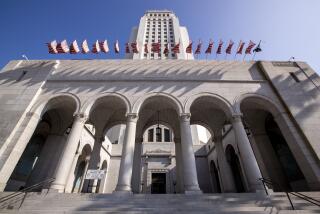Panel Often Down for Count
- Share via
It’s hard to get a quorum for meetings of the Significant Ecological Areas Technical Advisory Committee, also known as SEATAC. Keeping a quorum is harder still, because members sometimes must excuse themselves to avoid conflicts of interest.
The obscure panel’s seven members advise planning officials on building projects in the county’s 61 Significant Ecological Areas and recommend design features to reduce environmental damage.
SEATAC recommendations are based partly on biota reports submitted by consultants hired by developers. But in many cases, SEATAC members, four of whom are full- or part-time environmental consultants, must disqualify themselves because they have financial ties to the consulting firms submitting the reports.
Most of the conflicts involve a single SEATAC member: the panel’s current chairman, Dick Friesen.
Friesen, a biologist, works for Michael Brandman Associates, a large environmental consulting firm based in Santa Ana that works on some of the biggest projects planned for Significant Ecological Areas.
So many developers hire Brandman that Friesen must excuse himself at least once at almost every meeting. He was particularly silent at a June, 1989, meeting when six projects were discussed, four involving Brandman.
Friesen is highly regarded by fellow panel members and county planning staff who serve as liaisons to SEATAC.
SEATAC members are unpaid volunteers and there is no line forming to replace them, said Pamela Holt, a section head with the county Department of Regional Planning. Friesen’s situation “is something that . . . we’re monitoring closely,” Holt said. Planners would “like to keep him a member as long as it isn’t a problem,”
SEATAC member Gary Wallace, a botanist with the Los Angeles County Museum of Natural History, called Friesen a “crackerjack person” and said conflicts have “never been a problem at all.”
A dissenting view, however, was expressed by Carlyle W. Hall Jr., a Los Angeles attorney who has sued the county several times in land-use disputes. He described the Friesen situation as unworkable.
“I’m sure the guy tries to do a good job, but it’s a very obvious conflict,” Hall said. Even when Friesen disqualifies himself, as chairman, he has “some impact on the overall process implicitly, if not explicitly,” Hall said.
Hall said it is also possible that some developers retain Brandman “because they know that the Brandman guy is chairman” of the committee.
“I can’t help that perception, if that perception is there, but I don’t think that’s why people hire us,” Friesen said. He said it is Brandman’s size and prominence that ensures it a steady stream of clients.
Friesen said Brandman’s clients do not get favorable treatment. “I think SEATAC is harder on us than they are on anybody else. . . . They expect more from us,” he said.
On this point, the evidence is inconclusive.
During the past year, SEATAC drafted memos to county planners recommending rejection of two projects of Brandman clients that it regarded as highly destructive of ecological areas: a big housing and golf course project in the Valley Oaks Savannah area in Valencia and a residential tract in the Palo Comado area in Agoura.
On the other hand, a report prepared by Friesen personally on the impact of a project on an endangered species of ground squirrel in the Lovejoy Butte area in the Antelope Valley helped a developer win approval for a small subdivision there. Friesen recommended that the project be approved with the condition that the developer do a further study on the ground squirrel before getting a grading permit.
Friesen disqualified himself, SEATAC accepted his recommendation, and the project was approved last May.
More to Read
Sign up for Essential California
The most important California stories and recommendations in your inbox every morning.
You may occasionally receive promotional content from the Los Angeles Times.













